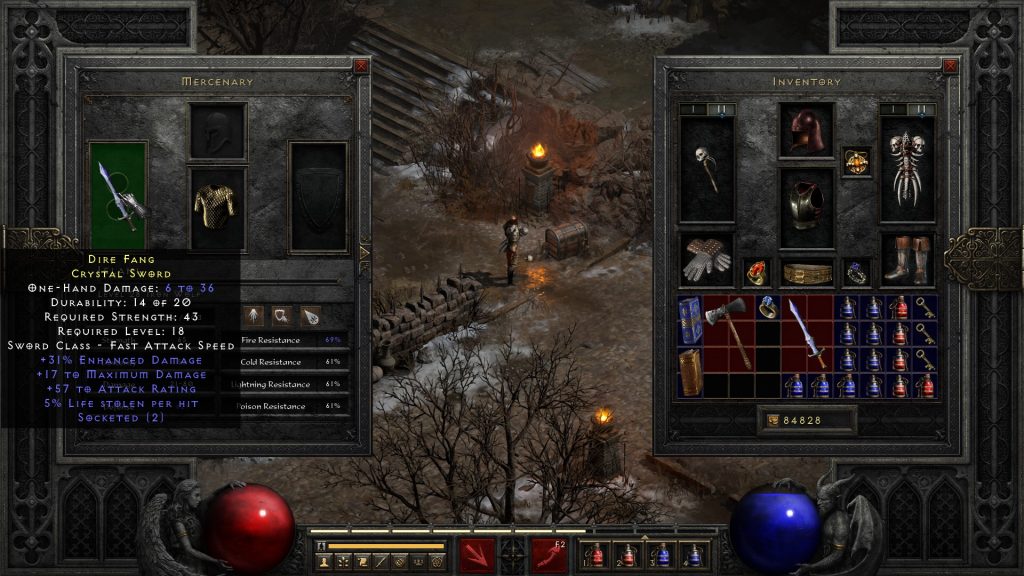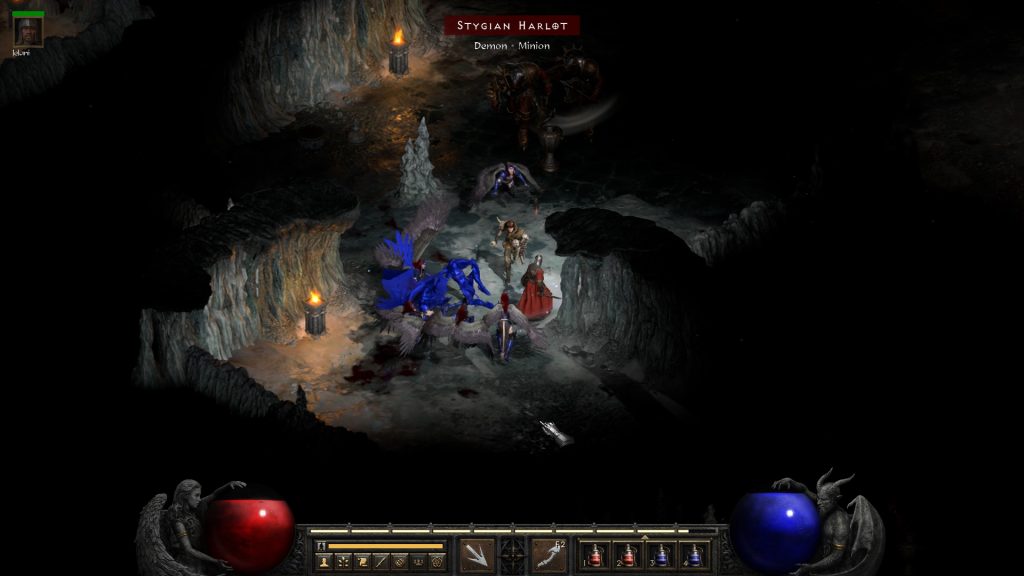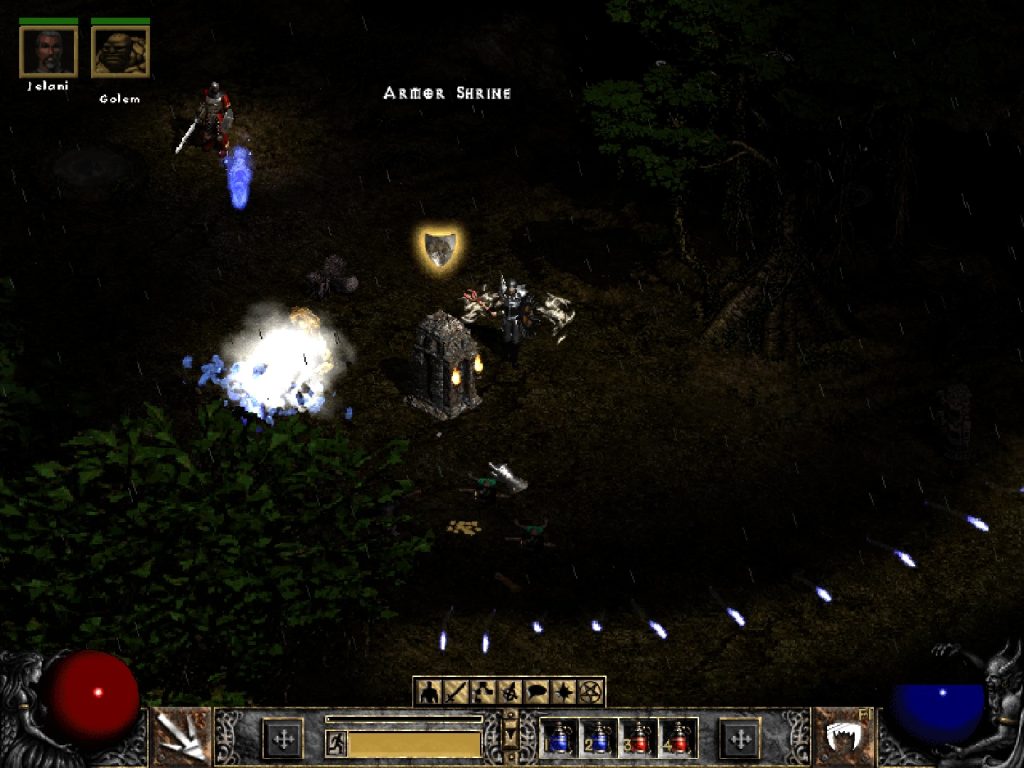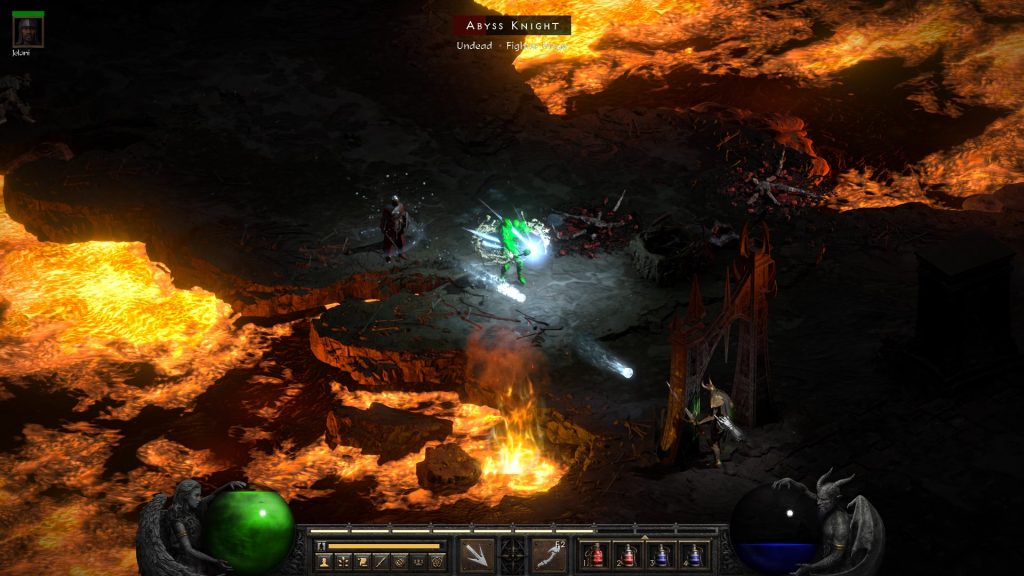Check out our video review:
Diablo is a classic. A landmark title that birthed loot-focused action RPGs as we know them today. In today’s world it definitely shows its age but it also holds up rather well in my opinion. The gameplay is fun, the replay value is high, and it can be enjoyed with others. Diablo was extremely successful and spawned a sequel. A sequel that I feel shaped the genre even further. Just like its predecessor, some consider Diablo II to be one of the greatest games ever made. It retains everything that defined its predecessor and introduces a lot of new stuff like skill trees, crafting, different item quality levels, gems and sockets, mercenaries, and more. In fact, much of what it introduced has become staples of the genre.

Developed by Blizzard North and published by Blizzard Entertainment, Diablo II was released for PC in June, 2000 and an expansion called Diablo II: Lord of Destruction was released in June, 2001. A remaster of Diablo II and its expansion called Diablo II: Resurrected was released for PC, PlayStation 4, PlayStation 5, Xbox One, the Xbox Series systems, and Switch in 2021. Resurrected comes with several features and improvements including an updated presentation that is overlaid atop the original and you can switch between the presentations at any time. For this review, I played Resurrected for PC. I’ve been very excited to do this review because this is the first time I have ever beaten Diablo II, including the expansion. Diablo II has always kicked my ass and I believe the reason is the result of a combination of things and I’ll get to that in a bit.
Before the playthrough for this review, the furthest I got was Act III and that was when I was playing with a friend. I don’t remember if we kept dying or life got in the way but we eventually just stopped. I consider myself decent at the genre. I can beat several games without any kind of assistance. I usually prefer to figure things out on my own and not use a build guide because building your character is all part of the fun. But because of my history with Diablo II, I did consult a build guide for this playthrough and when I reached Act IV, I was ecstatic. That said, I did end up straying from the guide a little mainly because I missed acquiring specific gear.

The story plays out in acts with cut scenes in between each and information is also conveyed through dialogue during gameplay. Set after the events of the previous game, the hero that defeated Diablo and trapped the demon’s spirit within his own body is becoming corrupted. He is dubbed the “Dark Wanderer” and as he travels the land, demons appear and wreak havoc. A new set of heroes make up the protagonists and set out to stop the Dark Wanderer from reuniting with the other prime evils. Lord of Destruction extends the story with a fifth act and centers on the prime evil know as Baal, and his attempts to corrupt a Worldstone. I feel Diablo II retains the grittiness of its predecessor (especially if viewing the original presentation) but doesn’t convey the same type of dark tone and atmosphere. In my opinion, Diablo is a bit darker in that regard. Diablo II feels more like an adventure. A dark fantasy adventure with numerous lands to explore and a great sense of scale. It’s not as small or claustrophobic (for lack of a better word) as its predecessor.
Before getting into the nitty gritty, I want to discuss what this review will be. As you can probably guess, I am far from an expert at Diablo II. I have not been playing it for decades, I have not mastered every build, I have not acquired every set item, and I don’t know every Rune Word and Horadric Cube recipe by heart. I do own and have played the original game before Resurrected released but I want to mention again that I played Resurrected for this review. And this review is coming from someone who has just beaten Diablo II for the first time. If you’re hoping for a deep dive into the math and numbers game for the best or most efficient build, this ain’t it. Also, I am aware of Diablo II’s age and legacy and keeping that in mind, this review will be covering what it’s like to play it in today’s world. If any of what I’ve just said doesn’t sit well with you, I advise you to stop reading now.

First I want to talk about what the expansion and Resurrected add to the experience. Lord of Destruction not only adds an additional act with new areas and extends the story but also adds two new character classes and revamps the gameplay. It comes with a lot of new items, improves hirelings or mercenaries, and it allowed the game to be played at a higher resolution among other things. As for Resurrected, it is considered a remaster and, personally, I think the updated presentation looks fantastic. Even the cut scenes have been redone and you can still watch the legacy ones if you so desire. Resurrected doesn’t just attempt to make things look prettier. It introduces a shared stash that lets players transfer items between characters, you can enable the option to automatically pick up gold, it supports cross-progression so you can play with your characters on different platforms, and it comes with several accessibility options.
Diablo II can be played solo or with others and before jumping into the gameplay, you must choose your character class and name your character. The classes include Assassin, Amazon, Necromancer, Barbarian, Paladin, Sorceress, and Druid and each one comes with different skills and starting stats. There are multiple difficulty levels and the harder ones do need to be unlocked. Harder difficulties include stronger and more varied monsters among other things but also better rewards. When creating your character, you have the option to create a Hardcore character which simply means permadeath. If the character dies, they are permanently dead. Multiplayer includes a Ladder Seasons system where players compete for the top rank every season. For my playthrough, I chose the Necromancer and played through the game solo and not Hardcore.

All of the mechanics from the previous game are present here along with new additions, quality of life features and changes, and general improvements. I’ll give a brief overview of some of the bigger ones. For starters, there’s an actual run mechanic now so you can move faster but running does drain stamina. Towns now have a stash chest for you to store items. You can buy tomes to store multiple town portal and identify scrolls. Belts determine the amount of quick item slots you have access to. The new skill system allows for different builds or playstyles. Each class comes with multiple skill trees and when you level up, you are awarded points to spend on stats or attributes and skills. Furthermore, you can reset your stats and skills. Magical or unique items return and now come in different quality levels and there’s also set items. The more items of the same set you have equipped, the more bonus properties are unlocked. A device called the Horadric Cube allows you to craft items. Some items come with sockets for things like gems, skulls, and runes to be inserted into for additional bonus properties. One of the most noticeable differences compared to the last game is the environments. You spend a lot more time outdoors in Diablo II and there are numerous dungeons to explore. Each act consists of a town or hub area and multiple areas and dungeons with waypoints that allow you to quickly travel between them.
Just like the previous game, the formula is pretty simple. Slay monsters, gain experience, level up, and acquire new toys to play with. The toys being loot, all the items in the game. Loot includes the same types as before but also many new items and types including throwing potions, charms which provide bonuses to the character when kept in their inventory, and gems, skulls, and runes that can be inserted into socketed items. Once again, the environment layouts and loot drops are randomized making each playthrough feel unique.

I think it’s safe to say character building is a big part of the loot-focused ARPG genre and in my opinion, Diablo II is what really defined this. Pumping points into the right stats and skills and equipping the proper gear in an effort to create a specific character build or playstyle. Some skills will enhance other skills and this is known as synergies. Proper point allocation and the right combination of stats, skills, and gear is very important on higher difficulties and things can get grindy if you’re really dedicated. Basically, a single character class can support multiple builds and I firmly believe it is possible to fuck up a build and hit a wall. Having a proper a build is all about knowing how everything relates to each other. Having the right stat values to equip the right gear, how the gear benefits your character and skills, and how the skills benefit each other. Building a character can be a trial and error process so I would say newcomers will need patience. If built correctly, your character can be a very powerful force. If built incorrectly, you may find yourself struggling which I believe was my problem in the past. Based on my own personal experience, compared to other games in the genre, including some modern ones, I feel Diablo II is not as forgiving with its builds but genre experts will probably correct me if I’m wrong.
I believe I was held back in previous playthroughs because of my builds. I was doing my own thing and pumping points into stats and skills I felt appropriate, and equipping gear I thought was good, but I guess I was wrong. Worst of all, when you die, your character is stripped of their current equipment and I really despise that feature. At least on the Normal difficulty level. I don’t mind losing gold or experience but don’t take away my shit. You can get your stuff back if you reach your dead body but that can be tedious. The feature frustrated me so much previously, it made me want to stop playing and that’s usually what I did. I did die a few times during this playthrough but I pushed through and I did struggle with two out of the five act bosses. In fact, Duriel, the boss of Act II, is one of them and is the wall I hit in many of my previous attempts. I would go so far to say that the act bosses are the real tests. I rarely had a problem reaching the bosses but the actual boss fights can be quite challenging if you’re not prepared. There are ways to cheese them but you should pay attention to your build and gear and know what you’re doing. In fact, based on my experience, I would say that’s good advice in general. You really need to know what you’re doing to succeed and avoid frustration in Diablo II.

The gear or what you equip is a big part of building your character. Some gear is class exclusive. Magical or unique gear grants bonus properties and if the gear has sockets, additional properties can be added by inserting gems, skulls, and runes into them. In fact, if you insert the correct combination of runes, they create rune words that grant specific properties. The only thing I don’t like about this is that Rune Words are not explained in-game. In today’s world, you can easily look them up online obviously but otherwise, there’s just no way to know. I believe there’s an NPC that alludes to them but the game doesn’t outright tell you about Rune Words or what they are which seems a little odd considering how efficient and important they can be. Based on my research, Rune Words were found in guides, online, and shared by players back in the day.
Just like in the previous game, the bonus properties items offer typically include benefits like improved damage, armor, and/or resistances. But some items have properties that benefit specific skills or regenerate health or mana among other things. It should also be noted that items now come in different quality levels and the higher the quality level, the better the properties. You can receive significant benefits from items and some are better for certain classes and builds. The right gear can make you more powerful or resilient or outright amplify certain skills and damage output. Even though most of the loot is randomized, there are ways to acquire and even make specific items that could be extremely beneficial for your character. The Horadric Cube is one way to do this. It basically allows you to craft things. However, it does require specific recipes. Just like Rune Words, the game doesn’t tell you what the recipes are. At the very least, it would have been nice if the game saved whatever Rune Words and recipes you’ve discovered into an index of some kind that you can reference.

Diablo II definitely features more variety than that of the previous game. More settings, more monsters, more items, more features. There are quests to complete in each act and many do flesh out the plot and you’ll battle your way through fields, deserts, dens, caves, sewers, lairs, tombs, tunnels and temples. Monsters are always found outside of the towns and every so often, you’ll encounter unique monsters which are stronger than their standard counterparts. One complaint I have is that some of the areas are too similar. I really noticed it in Act V which is one of my favorite acts in the game just for the atmosphere alone. Each act takes you to a new location and has its own theme and monsters. But many of the dungeons within an act look and feel the same.
Most areas and dungeons are large and dungeons often have multiple floors to explore. I made sure to take my time to explore every nook and cranny and clear out all monsters before progressing to the next area or floor. Chests are littered about the environments and can contain loot and you should be mindful of traps and hazards. One cool feature is that you can hire mercenaries to assist or follow you. They come with their own skills and/or spells, can be equipped with items, and will level up. They can actually prove to be quite helpful.
Diablo II’s original or legacy presentation definitely shows its age but I do think it’s an improvement over its predecessor. Environments are detailed and varied, character and enemy models look good, and some of the gore effects make for very satisfying kills. There’s also a grittiness to it that is somewhat lost in Resurrected’s presentation. Nevertheless, Resurrected still looks great in my opinion. From the texture work to the lighting to the 3D models, it all looks fantastic as do the updated cut scenes. Best of all, you can switch between the presentations at the press of a button. On the audio side, the sound work is well done and Diablo II is another showcase for excellent music. There’s different tunes for each act and they all fit in well and help drive home the game’s overall sinister atmosphere. I really enjoyed some of the tunes heard in Act V, giving off a cinematic sounding quality in my opinion. On the technical side, I’m happy to say the game ran fine and I did not encounter any issues. It should be known that the presentation will dictate the frame rate. The legacy presentation will run at the game’s original 25 frames per second and Resurrected can run at 60 and will look much smoother.

I would go so far say that Diablo II is one of the greatest sequels ever made and one of the best games in the genre. When compared to its predecessor and for the time it released, in my opinion the sheer scale of what’s on display here is quite impressive as is the amount of options available to the player. From the character building to the randomization, the replay value is insane. It is more of the same in some respects but there’s just so much more here to play and experiment with. I feel Diablo II did set some new standards for the genre. Building a character that reaches its maximum potential, especially on higher difficulties, will be trial and error without a guide and things can get grindy. Based on experience, I feel if you don’t know what you’re doing, you can hit a wall resulting in frustration. That could mean you’ll have to reset stats and skills or maybe even restart with a fresh character. Building a character is all part of the fun but I would suggest newcomers consult a build guide. You don’t have to, of course, and I know some will say that ruins the fun. I would even agree with that but I would also say Diablo II can seriously punish improper builds. Yes, even on Normal. A proper build is definitely more important on higher difficulties but Normal can still kick your ass if you don’t know what you’re doing. One piece of advice I will give is don’t pump points into every skill available. Commit to certain ones, to a certain playstyle. Diablo II is a lot of fun and can be very rewarding if you have the patience.
I absolutely recommend Diablo II and that includes Resurrected. The game still has an active community and there are some excellent mods out there as well. It may show its age but it’s still a fun time and a big improvement over its predecessor. It’s got more features, more variety, and more depth. Just like Diablo, I would say Diablo II is a classic and a must play for fans of the genre. Definitely check it out.
